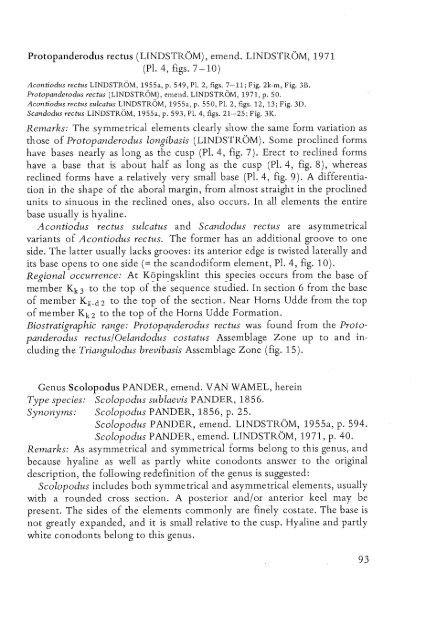UTRECHT MICROPALEONTOLOGICAL BUllETINS
UTRECHT MICROPALEONTOLOGICAL BUllETINS
UTRECHT MICROPALEONTOLOGICAL BUllETINS
You also want an ePaper? Increase the reach of your titles
YUMPU automatically turns print PDFs into web optimized ePapers that Google loves.
Protopanderodus rectus (LINDSTROM), emend. LINDSTROM, 1971<br />
(PI. 4, figs. 7-10)<br />
Acontiodus rectus LINDSTROM, 1955a, p. 549, PI. 2, figs. 7-11; Fig. 2k-m, Fig. 3B.<br />
Protopanderodus rectus (LINDSTROM), emend. LINDSTROM, 1971, p. 50.<br />
Acontiodus rectus sulcatus LINDSTROM, 1955a, p. 550, PI. 2, figs. 12, 13; Fig. 3D.<br />
Scandodus rectus LINDSTROM, 1955a, p. 593, PI. 4, figs. 21-25; Fig. 3K.<br />
Remarks: The symmetrical elements clearly show the same form variation as<br />
those of Protopanderodus longibasis (LINDSTROM). Some proclined forms<br />
have bases nearly as long as the cusp (PI. 4, fig. 7). Erect to reclined forms<br />
have a base that is about half as long as the cusp (PI. 4, fig. 8), whereas<br />
reclined forms have a relatively very small base (PI. 4, fig. 9). A differentiation<br />
in the shape of the aboral margin, from almost straight in the proclined<br />
units to sinuous in the reclined ones, also occurs. In all elements the entire<br />
base usually is hyaline.<br />
Acontiodus rectus sulcatus and Scandodus rectus are asymmetrical<br />
variants of Acontiodus rectus. The former has an additional groove to one<br />
side. The latter usually lacks grooves: its anterior edge is twisted laterally and<br />
its base opens to one side (= the scandodiform element, PI. 4, fig. 10).<br />
Regional occurrence: At K~pillgsklint this ~pecies occurs from the base of<br />
member Kk3 to the top of the sequence studied. In section 6 from the base<br />
of member Ka- d 2 to the top of the section. Near Horns Udde from the top<br />
of member Kk 2 to the top of the Horns Udde Formation.<br />
Biostratigraphic range: Protopqnderodus rectus was found from the Protopanderodus<br />
rectus/Oelandodus costatus Assemblage Zone up to and including<br />
the Triangulodus brevibasis Assemblage Zone (fig. 15).<br />
Genus Scolopodus PANDER, emend. VAN WAMEL, herein<br />
Type species: Scolopodus sublaevis PANDER, 1856.<br />
Synonyms: Scolopodus PANDER, 1856, p. 25.<br />
Scolopodus PANDER, emend. LINDSTROM, 1955a, p. 594.<br />
Scolopodus PANDER, emend. LINDSTROM, 1971, p. 40.<br />
Remarks: As asymmetrical and symmetrical forms belong to this genus, and<br />
because hyaline as well as partly white conodonts answer to the original<br />
description, the following redefinition of the genus is suggested:<br />
Scolopodus includes both symmetrical and asymmetrical elements, usually<br />
with a rounded cross section. A posterior and/or anterior keel may be<br />
present. The sides of the elements commonly are finely costate. The base is<br />
not greatly expanded, and it is small relative to the cusp. Hyaline and partly<br />
white conodonts belong to this genus.
















